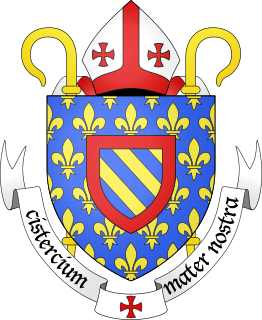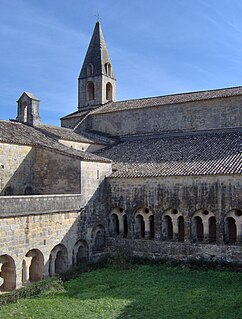
Belleperche Abbey (bella pertica) is a former Cistercian abbey in Tarn-et-Garonne, Occitanie, in France, about 7 kilometres south of Castelsarrasin and 20 kilometres west of Montauban, situated on the Garonne.

Belleperche Abbey (bella pertica) is a former Cistercian abbey in Tarn-et-Garonne, Occitanie, in France, about 7 kilometres south of Castelsarrasin and 20 kilometres west of Montauban, situated on the Garonne.
The monastery was founded between 1130 and 1140 by the d'Argombat family at a location about 10 kilometres from the later site. In 1143 it affiliated itself as a daughter house of the Cistercian primary Clairvaux Abbey. At this point it was transferred to an allod on the bank of the Garonne, where it carried out viniculture, horse-breeding, and cattle-breeding. Belleperche became one of the largest monasteries in southern France, with eight granges, including Angeville, and 60-80 monks in its heyday. The original building was already replaced by 1230 with a new construction on enlarged foundations on the riverbank. In 1563 a new Abbot's lodge was erected.
The abbey's decline began with the Hundred Years' War, and further damages were caused in 1572, during the Huguenot Wars. The monastery was restored (1604-1614), but was dissolved in 1791 as a result of the French Revolution. The abbey was converted into a castle, agricultural estates, and domestic residences, and unused buildings were demolished or fell into ruin.
A restoration was begun in 1993.
The now demolished church was consecrated in 1263. It was 75 metres long and 20 wide, with polychromatic floor-tiles and an octagonal bell tower, modelled on Saint Sernin in Toulouse, above the crossing. The six bays of the chapter house were vaulted between 1250 and 1255. The rectangular cloister measured approximately 46 x 38 metres.

The Cistercians officially the Order of Cistercians, are a Catholic religious order of monks and nuns that branched off from the Benedictines and follow the Rule of Saint Benedict. They are also known as Bernardines, after the highly influential Bernard of Clairvaux or as White Monks, in reference to the colour of the "cuculla" or cowl worn by the Cistercians over their habits, as opposed to the black cowl worn by Benedictines.

Buckfast Abbey forms part of an active Benedictine monastery at Buckfast, near Buckfastleigh, Devon, England. Buckfast first became home to an abbey in 1018. The first Benedictine abbey was followed by a Savignac abbey constructed on the site of the current abbey in 1134. The monastery was surrendered for dissolution in 1539, with the monastic buildings stripped and left as ruins, before being finally demolished. The former abbey site was used as a quarry, and later became home to a Gothic mansion house.

Orval Abbey is a Cistercian monastery founded in 1132 in the Gaume region of Belgium and is located in Villers-devant-Orval, part of Florenville in the province of Luxembourg. The abbey is well known for its history and spiritual life but also for its local production of the Trappist beer Orval and a specific cheese.

Aiguebelle Abbey is a Trappist monastery situated in the communes of Montjoyer and Réauville in the département of Drôme, on the borders of the Dauphiné and of Provence, France.

Thoronet Abbey is a former Cistercian abbey built in the late twelfth and early thirteenth century, now restored as a museum. It is sited between the towns of Draguignan and Brignoles in the Var Department of Provence, in southeast France. It is one of the three Cistercian abbeys in Provence, along with the Sénanque Abbey and Silvacane, that together are known as "the Three Sisters of Provence."

The Abbey of Fontenay is a former Cistercian abbey located in the commune of Marmagne, near Montbard, in the département of Côte-d'Or in France. It was founded by Saint Bernard of Clairvaux in 1118, and built in the Romanesque style. It is one of the oldest and most complete Cistercian abbeys in Europe, and became a UNESCO World Heritage Site in 1981. Of the original complex comprising church, dormitory, cloister, chapter house, caldarium, refectory, dovecote and forge, all remain intact except the refectory and are well maintained. The Abbey of Fontenay, along with other Cistercian abbeys, forms a connecting link between Romanesque and Gothic architectures.

Boyle Abbey was the first successful foundation in Connacht of the Cistercian order which had opened its first Irish house at Mellifont, County Louth, in 1142.

Bellevaux Abbey was a Cistercian monastery, founded in 1120 by Pons de Morimond, near the present-day Cirey, Haute-Saône, France. At that time it was in Franche-Comté. It was suppressed in 1790 and sold in 1791. Shortly afterwards the church was demolished. 1795 the buildings were bought by Jean-Charles Pichegru.

Castelmayran is a commune in the Tarn-et-Garonne department in the Occitanie region in southern France.

Grandselve Abbey was a Cistercian monastery in south-west France, at Bouillac, Tarn-et-Garonne. It was one of the most important Cistercian abbeys in the south of France.
Gerald of Sales was a French monastic reformer from Salles, Lot-et-Garonne near Bergerac, Dordogne in the south-west of France. His feast day is on April 20.

The Trappist Abbey of Rochefort or Abbey of Notre-Dame de Saint-Rémy, which belongs to the Cistercians of Strict Observance, is located in Rochefort in the province of Namur. The abbey is famous for its spiritual life and its brewery, which is one of few Trappist beer breweries in the world. Life in the abbey is characterised by prayer, reading and manual work, the three basic elements of Trappist life. The motto of the abbey is Curvata Resurgo.

Acey Abbey is a Cistercian abbey founded in 1136, and occupied since 1873 by Trappist monks. It is located in Vitreux in the department of Jura, France, on the River Ognon, about 26 kilometres north-north-east of Dole and about 7 kilometres north of Gendrey.

Klaarkamp Abbey was a Cistercian monastery in the community of Dongeradeel, about 4 kilometres southwest of Dokkum and 2 kilometres north of Rinsumageast in the Dutch province of Friesland.

Valmagne Abbey is a former Benedictine monastery located near Villeveyrac, Hérault, in south-central France. It is a designated historic monument.
not to be confused with Belloc Abbey in Urt; for other uses see Beaulieu
Les Feuillants Abbey, also Feuillant Abbey, was a Cistercian monastery located in the present commune of Labastide-Clermont, about 8 kilometres south of Rieumes, department of Haute-Garonne, France. From the 16th century it was the centre of the Cistercian reform movement to which it gave its name, the Feuillants.

Signy Abbey was a Cistercian abbey located in Signy-l'Abbaye, Ardennes, France. It is located about 65 kilometres (40 mi) northeast of Reims and about 28 kilometres (17 mi) west of Charleville-Mézières on the edge of the Froidmont forest. It was founded on 25 March 1135, the feast day of the Annunciation. It was sold as national property in 1793 and completely demolished. Its library was burned.
Gondon Abbey is a former Cistercian monastery in Monbahus, Lot-et-Garonne, Aquitaine, France, about 21 kilometres to the north-west of Villeneuve-sur-Lot.

Prières Abbey is a former Cistercian monastery in the commune of Billiers in the department of Morbihan, Brittany, France, about 28 kilometres southeast of Vannes near the coast and the mouth of the River Vilaine.